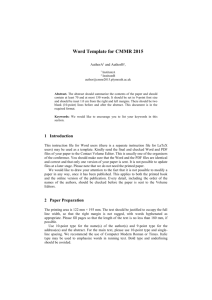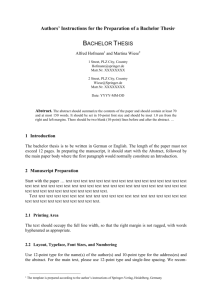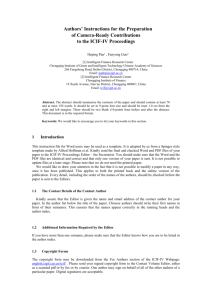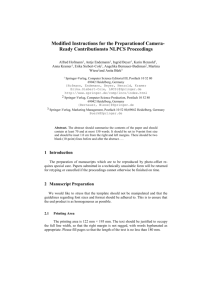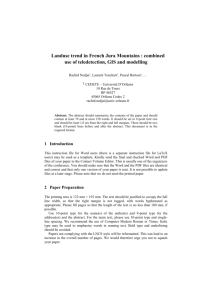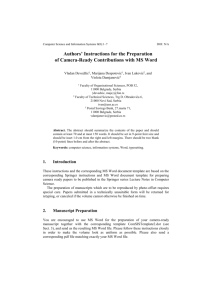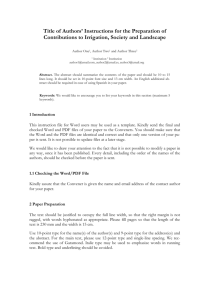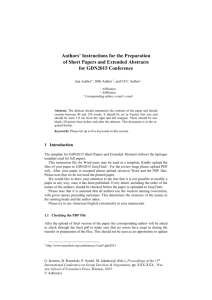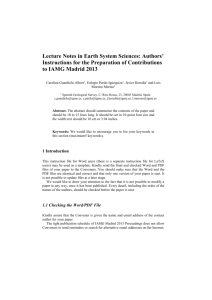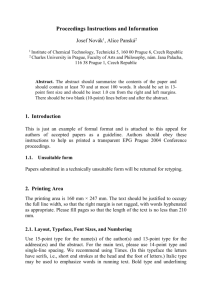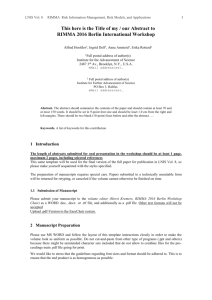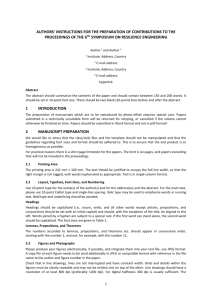MS Word
advertisement
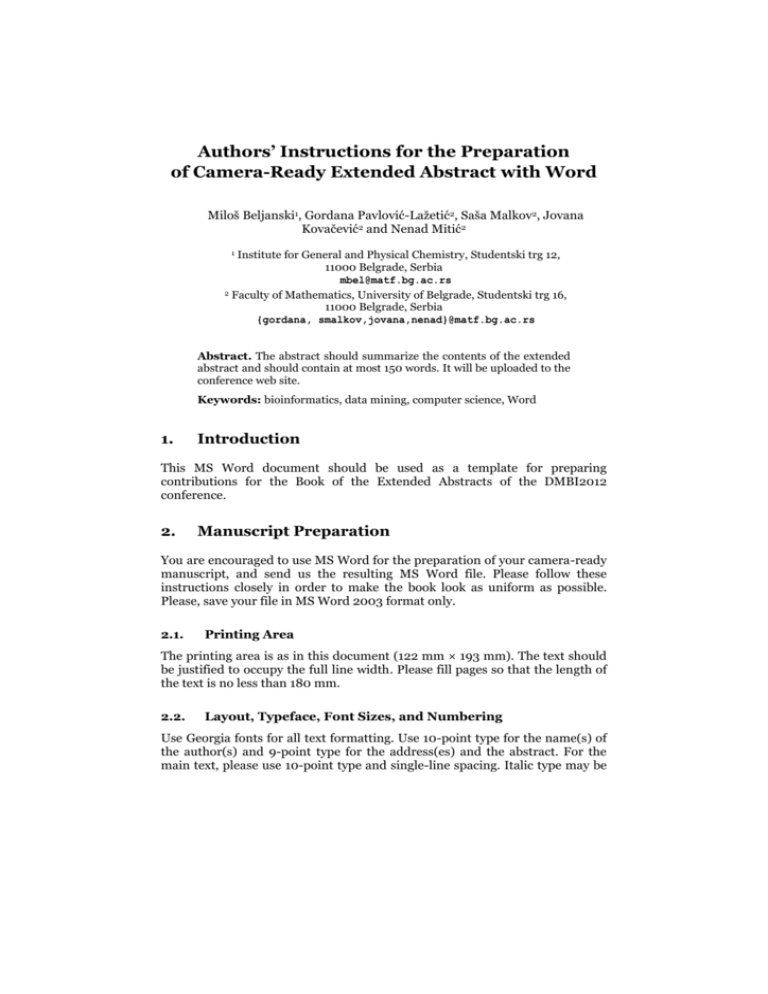
Authors’ Instructions for the Preparation
of Camera-Ready Extended Abstract with Word
Miloš Beljanski1, Gordana Pavlović-Lažetić2, Saša Malkov2, Jovana
Kovačević2 and Nenad Mitić2
Institute for General and Physical Chemistry, Studentski trg 12,
11000 Belgrade, Serbia
mbel@matf.bg.ac.rs
2 Faculty of Mathematics, University of Belgrade, Studentski trg 16,
11000 Belgrade, Serbia
{gordana, smalkov,jovana,nenad}@matf.bg.ac.rs
1
Abstract. The abstract should summarize the contents of the extended
abstract and should contain at most 150 words. It will be uploaded to the
conference web site.
Keywords: bioinformatics, data mining, computer science, Word
1.
Introduction
This MS Word document should be used as a template for preparing
contributions for the Book of the Extended Abstracts of the DMBI2012
conference.
2.
Manuscript Preparation
You are encouraged to use MS Word for the preparation of your camera-ready
manuscript, and send us the resulting MS Word file. Please follow these
instructions closely in order to make the book look as uniform as possible.
Please, save your file in MS Word 2003 format only.
2.1.
Printing Area
The printing area is as in this document (122 mm × 193 mm). The text should
be justified to occupy the full line width. Please fill pages so that the length of
the text is no less than 180 mm.
2.2.
Layout, Typeface, Font Sizes, and Numbering
Use Georgia fonts for all text formatting. Use 10-point type for the name(s) of
the author(s) and 9-point type for the address(es) and the abstract. For the
main text, please use 10-point type and single-line spacing. Italic type may be
used to emphasize words in running text. Bold type and underlining should be
avoided.
Headings. Headings should be capitalized (i.e., nouns, verbs, and all other
words except articles, prepositions, and conjunctions should be set with an
initial capital) and should, with the exception of the title, be aligned to the left.
The font sizes are given in Table 1.
Table 1. Font sizes of headings. Table captions should always be positioned above the
tables. Tables should be horizontally centered. The final sentence of a table caption
should end without a period
Heading level
Title (centered)
Example
1st-level heading
2nd-level heading
3rd-level heading
4th-level heading
1. Introduction
Authors’ Instructions
2.1. Printing Area
Headings. Text follows …
Remark. Text follows …
Font size and style
14 point, bold
12 point, bold
10 point, bold
10 point, bold
10 point, italic
Here are some examples of headings: "Criteria to Disprove ContextFreeness of Collage Languages", "On Correcting the Intrusion of Tracing Nondeterministic Programs by Software", "A User-Friendly and Extendable Data
Distribution System", "Multi-flip Networks: Parallelizing GenSAT", "Selfdeterminations of Man".
2.3.
Figures and Photographs
Please produce your figures electronically, if possible, and integrate them into
your text file. For figures we suggest to use 600dpi (or more). For digital
halftones 300 dpi is usually sufficient. If possible, the files of figures (e.g. EPS
files) should not contain binary data, but be saved in ASCII format.
Figures should be numbered and should have a caption which should
always be positioned under the figures, in contrast to the caption belonging to
a table, which should always appear above the table. Please center the
captions between the margins and set them in 9-point type (Fig. 1 shows an
example).
Fig. 1. One kernel at xs (dotted kernel) or two kernels at xi and xj (left and right) lead
to the same summed estimate at xs. This shows a figure consisting of different types of
lines. Elements of the figure described in the caption should be set in italics, in
parentheses, as shown in this sample caption.
2.4.
Formulas
Displayed equations or formulas are centered and set on a separate line (with
an extra line or half line space above and below). Displayed expressions should
be numbered for reference. For example,
x+y=z
2.5.
(1)
Program Code
Program listings or program commands in the text are normally set in
typewriter font, Courier New.
Example of a Computer Program from Jensen K., Wirth N. (1991) Pascal
user manual and report. Springer, New York:
program Inflation (Output)
{Assuming annual inflation rates of 7%, 8%, and
10%,...
years};
const
var
MaxYears = 10;
Year: 0..MaxYears;
Factor1, Factor2, Factor3: Real;
begin
Year := 0;
Factor1 := 1.0; Factor2 := 1.0; Factor3 := 1.0;
WriteLn('Year 7% 8% 10%'); WriteLn;
repeat
Year := Year + 1;
Factor1 := Factor1 * 1.07;
Factor2 := Factor2 * 1.08;
Factor3 := Factor3 * 1.10;
WriteLn(Year:5,Factor1:7:3,Factor2:7:3,
Factor3:7:3)
until Year = MaxYears
end.
2.6.
Footnotes
The superscript numeral used to refer to a footnote appears in the text either
directly after the word to be discussed or – in relation to a phrase or a
sentence – following the punctuation sign (comma, semicolon, or period).
2.7.
Citations
The list of references is headed “References” and is not assigned a number in
the decimal system of headings. The list should be set in small print and
placed at the end of your contribution, in front of the appendix, if one exists.
Please do not insert a page break before the list of references if the page is not
completely filled. An example is given at the end of this information sheet. For
citations in the text please use square brackets and consecutive numbers: [1],
[2], [3], …
2.8.
Page Numbering and Running Heads
Your paper should show no printed page numbers; these are allocated by the
publisher. Do not set running heads.
3.
Supplementary Material
If you have supplementary material, simply include note with reference of the
URL at which it can be found.
References
1. Agrawal, R., Srikant, R.: Fast Algorithms for Mining Association Rules. In Proceedings of
the 20th International Conference on Very Large Databases. Morgan Kaufmann,
Santiago, Chile, 487-499. (1994)
2. Garcia-Molina, H., Ullman, D. J., Widom, J.: Database Systems: The Complete Book.
Prentice Hall, New Jersey, USA. (2002)
3. Wang, X., Bettini, C., Brodsky, A., Jajoida, S.: Logical Design for Temporal Databases
with Multiple Granularities. ACM Transactions on Database Systems, Vol. 22, No. 2, 115170. (1997)
4. Bruce, K. B., Cardelli, L., Pierce, B. C.: Comparing Object Encodings. In: Abadi, M., Ito,
T. (eds.): Theoretical Aspects of Computer Software. Lecture Notes in Computer Science,
Vol. 1281. Springer-Verlag, Berlin Heidelberg New York, 415–438. (1997)
5. van Leeuwen, J. (ed.): Computer Science Today. Recent Trends and Developments.
Lecture Notes in Computer Science, Vol. 1000. Springer-Verlag, Berlin Heidelberg New
York (1995)
6. Ribière, M., Charlton, P.: Ontology Overview. Motorola Labs, Paris (2002). [Online].
Available: http://www.fipa.org/docs/input/f-in-00045/f-in-00045.pdf (current October
2003)
